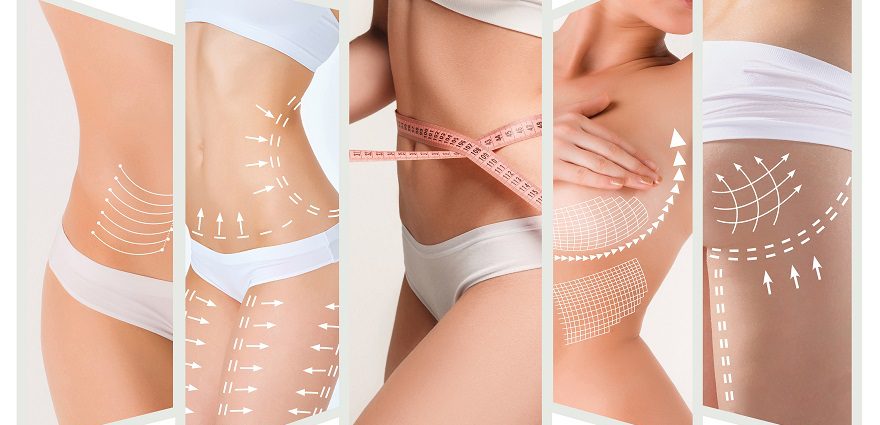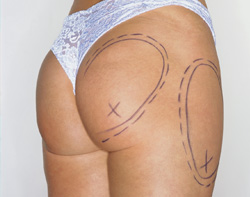Body Lift Surgery
Medically Reviewed by: Dr. John Kim

Here you’ll find information on:
- Popular procedures
- Is it right for me?
- Consult a qualified plastic surgeon
- The procedure
- Follow-up procedures
- After surgery
- Complications and risks
- Costs
A body lift is a plastic surgery procedure that improves the appearance of the abdomen, buttocks, thighs and breasts. There are two main types of body lifts — the lower body lift, or belt lipectomy, and the upper body lift. When upper and lower body lifts are performed on the same person, it is referred to as a total body lift.
In general, a body lift aims to improve the shape and tone of the underlying tissue that supports fat and skin. It is typically performed after massive weight loss, including that which occurs after bariatric surgery. The procedure may also be performed to offset the physical effects of aging and childbearing. In the latter scenario, it is often referred to as part of a mommy makeover.
A newer approach known as corset trunkplasty, or corset procedure, creates a sleeker waistline by removing loose skin in both the upper and lower abdomen. A thigh or butt lift can be performed at a later date to complete the body transformation.
Popular Body Contouring Procedures
According to the American Society of Plastic Surgeons, the top four body contouring procedures performed following massive weight loss are:
- Extended abdominoplasty / lower body lift
- Thigh lift
- Upper arm lift
- Breast lift / reduction
Those interested in body contouring surgeries following weight loss surgery also may be interested in evaluating other complementary cosmetic procedures, such as post-bariatric facelift surgery and neck lift.
Is it Right for Me?
The body lift procedure isn’t right for every body. If you have had weight loss surgery (such as gastric bypass or Lap Band), you should wait 12 to 18 months before considering a body lift. This should provide adequate time for you to lose weight and adjust to the necessary diet and lifestyle changes following surgery.
People who have had weight loss surgery often require contouring procedures on various parts of their body, including the face, breast, flank, stomach, thighs and arms. The exact sequence of these multiple surgeries will vary based on individual needs and expectations, as well as the surgeon’s style and experience.
The ideal candidate for body lift exercises regularly, eats a healthy diet and has been at a stable weight for at least three months; but hopefully six. Special laboratory testing is important so that mineral, vitamin and protein deficiencies — which are common in people who have had weight loss surgery — are identified and treated.
Women considering a body lift who are also planning to have children should consider delaying the procedure until after they have given birth.
Selecting a Surgeon
The body lift is an extensive surgery best performed by an experienced plastic surgeon. Since the techniques are still evolving, the ASPS and the American Society for Aesthetic Plastic Surgery (ASAPS) hold many courses and seminars to better educate plastic surgeons about post-bariatric surgery.
Ask your selected plastic surgeon about his or her experience with body lifts, and ask to talk to some past patients.
Another important consideration when selecting your surgeon is board certification. There are more than 150 self-designated boards providing some form of certification, but only a few are designated by the American Board of Medical Specialties (ABMS). For example, the American Board of Plastic Surgery is designated by the ABMS. Make sure that the plastic surgeon you choose is certified by the American Board of Plastic Surgery. This certification assures that he or she is up-to-date on the latest developments in the field.
About the Procedure
Body lift surgery is most often performed in a hospital, though the procedure may be performed in an accredited outpatient surgical center.
Your body mass index (BMI) may play a role in whether your procedure is performed in a hospital or in an outpatient facility, as it determines the length of the procedure.
Typically, surgery ranges from four to seven hours and is performed under general anesthesia.
Lower body lifts typically begin with the belt-like excision above the buttocks and lateral (outer side) thighs. The thigh skin may be separated to assist in the lift.
After a tight closure, your surgeon will begin the abdominoplasty procedure. He or she will make a horizontal incision along the pubic area and remove the tissues from the underlying muscles to the level of the belly button. Your surgeon will then separate the skin between the belly button and central rib cage. If fat removal is required, he or she will perform liposuction in this area and around the waist.
Once the excess skin has been removed, the surgeon tightens the abdominal wall muscle. This second step of the procedure is one difference between a tummy tuck and a panniculectomy, since the latter only involves removing the excess skin. The remaining skin and fat is moved down from the area above the belly button and sutured in position at the pubic area. Your belly button can then be restored to its original position.
An upper body lift begins with a broad bra-line excision of skin. Once this is securely closed, the back fat rolls are removed and the waist is narrowed. Next, your surgeon may remove any excess skin from under the breasts or hanging over the lower rib cage. The subsequent closure tightens the skin under the breasts. The newly elevated abdominal skin must be deeply sutured to the lower rib cage.
Men who undergo upper body lifts can be treated for gynecomastia.
Total Body Lift and Follow-Up Procedures
A total body lift combines the traditional body lift procedure with supplemental treatments performed at the same time, or at sequenced time intervals.
There are increased risks when having multiple treatments performed simultaneously. Most surgeons will perform a series of body contouring procedures in stages after weight loss surgery to minimize these risks. For example, this may start with a lower body lift (the tummy, the thighs, buttocks and back) and be followed by a breast lift and complete inner thigh reconstruction several months later. The face, neck and arms may also receive treatment several months down the road.
Two of the more commonly performed body lift follow-up procedures include:
- Arm Lift: An arm lift, or brachioplasty, reduces excess skin and fat between the underarm and the elbow. This procedure reshapes your arm for a more trim and toned appearance. The arm lift procedure requires two relatively inconspicuous incisions. One is made along the armpit, while the other spans the elbow to the armpit. Your surgeon will remove excess fat with liposuction and trim the excess skin. The remaining skin is pulled together and sutured in place. People who opt for the arm lift procedure will have dressings applied to the incision areas. A medical compression garment may be prescribed for a month. (Read more about arm lift)
- Inner Thigh Lift: Typically this type of thigh lift procedure is performed via an incision made where the thigh meets the groin. In severe cases, a secondary incision extending from the groin to the knee may be necessary. Your surgeon will remove excess fat with liposuction and trim the excess skin. The remaining skin is pulled together and sutured in place. People who have inner thigh lifts will have dressings applied to the incision areas. A medical compression garment will be prescribed for a month.
Post-Surgical Care
The body lift procedure is a major surgery that often requires a hospital stay of one to three days. You should expect a recovery period of six weeks or longer.
Intravenous or intramuscular medications are used immediately after surgery for pain and discomfort. Eventually, oral pain medication will replace these more intensive treatments. Several drains are usually placed to remove blood. When the output of drainage fluid is low, these drains can be safely removed.
To limit the potential for body lift complications, your surgeon will likely outline a specific dietary plan. A complete instruction list will also be provided to help you through your recovery.
Personal home care is required for up to two weeks after the insertion of drainage tubes, which stave off fluid buildup and swelling. Your body lift surgeon may also prescribe a medical compression garment to aid recovery. This should be worn at all times, except when bathing. Your dressings will be removed within two weeks of surgery, at which point you may shower.
As you begin to transition back into your normal routine, it is important to make yourself aware of certain restrictions on your activities following body lift.
For example, your surgeon may restrict exercise — though walking is encouraged — and lifting more than five pounds. You should avoid placing any pressure on the treated area. Within six weeks after surgery, approximately 75 percent of the swelling should subside; 90 percent within three months.
The average recovery time is four to six weeks, after which most people may adopt their normal routine. It is wise to allow six to eight weeks before exercising.
Every situation is unique, so make sure to ask your doctor when it is okay for you to get back to your usual activities.
Body Lift Complications and Risks
There are complications and risks associated with any medical procedure. Common complications associated with the body lift procedures include the potential for small skin separations and subcutaneous fluid accumulation (seroma).
Additional complications and risks that may result from body lift include:
- Reduced sensation in the treatment area (may be permanent.)
- Infection
- Bleeding
- Hematoma (a mass of clotted blood)
- Scarring. Although your scars will never heal completely, and may appear to worsen during the first weeks or months after treatment, they should eventually flatten and lighten.
- Fluid accumulation
- Poor wound healing
- Skin loss
- Skin discoloration and/or prolonged swelling
- Fatty tissue found deep in the skin might die (fat necrosis)
- Asymmetry
- Pain
- Deep vein thrombosis (blood clot in the legs)
- Pulmonary embolism (blood clot in the lungs)
- Persistent swelling in the legs
- Possibility of revisional surgery
Ask your surgeon to fully explain all risks and complications associated with the procedure during your initial consultation.
Cost
The cost of body lift surgery is determined based on the surgeon’s fee, the hospital or facility fee and the anesthesia fee. The costs associated with the hospital and surgeon’s fees vary greatly. Depending on your level of coverage, insurance may cover the total cost of your body lift if deemed a medical necessity.
Body lift surgery costs approximately $12,000 to $50,000. Your exact cost of treatment will depend on the extent of the procedure and the duration of your recovery. Bariatric procedures that are performed on an elective basis typically are not covered by most insurance plans. This issue of insurance coverage also is seen in other medical industries such as dentistry. Dental insurance does not cover elective cosmetic procedures like Lumineers.
To help you manage the cost, many body lift surgeons offer payment plans allowing for monthly installments paid over extended periods.
(Visit our sister site Consumer Guide to Plastic Surgery to learn more about plastic surgery procedures.)
About the Reviewer
John Kim, MD, is a board-certified plastic surgeon who is Clinical Director of Plastic Surgery at the Northwestern University Feinberg School of Medicine. Dr. Kim has published more than 50 articles and chapters regarding plastic surgery; has had his work featured by ABC News and the Chicago Sun Times, among other; holds several medical device patents; and sits on the editorial board of the Annals of Plastic Surgery, as well as many American Society of Plastic Surgeons committees. www.drkimsurgery.com



